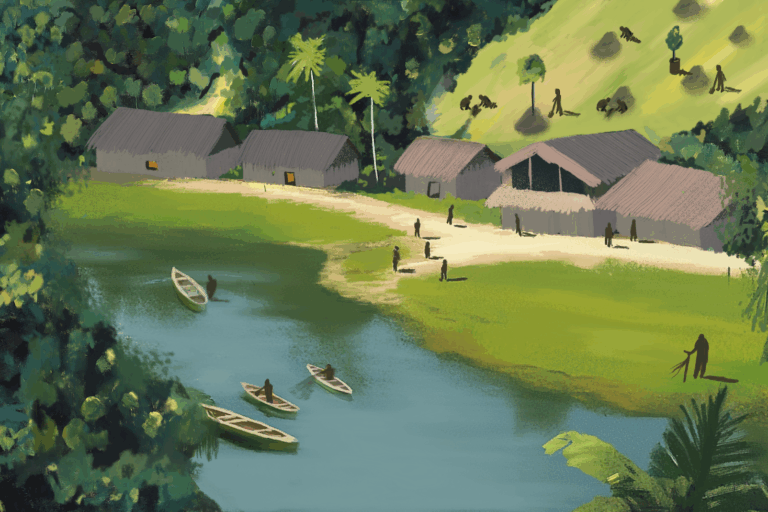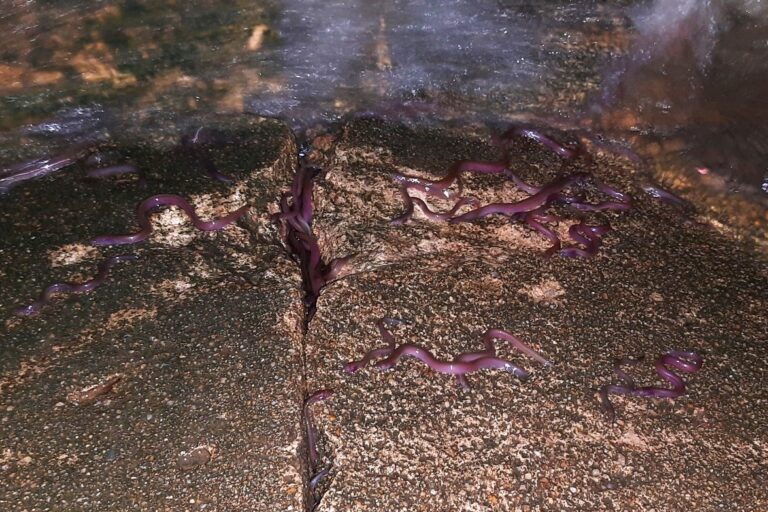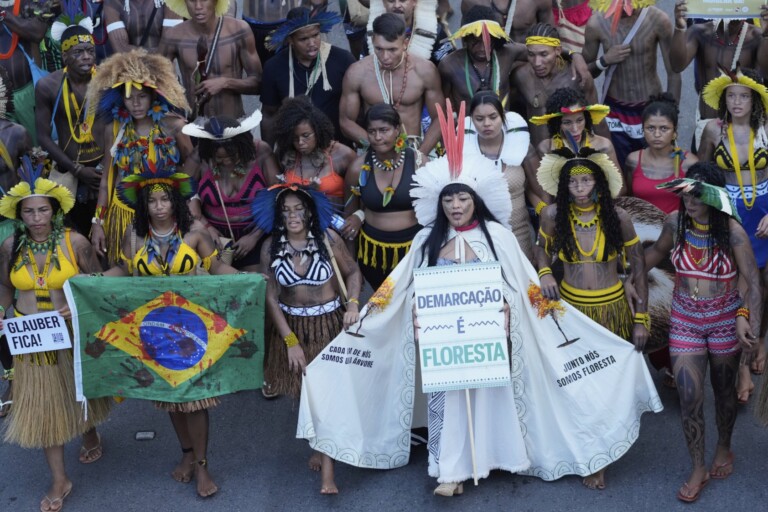- Paying fishers in Indonesia to not catch sharks and rays could be a cost-effective way of conserving these species, a new study suggests.
- Interviews with fishers at two sites shows that payments of $71,408-$235,927 per year could protect up to 18,500 hammerheads and 2,140 wedgefish at those sites.
- Researchers say this money could come from dive tourism levies, and they are already carrying out a pilot project that has seen fishers release more than 150 hammerheads and wedgefish in eight months.
- An independent expert cautions that there need to be safeguards to prevent a perverse incentive where fishers are deliberately catching these species just so they can release them and claim payment.
More than a third of all elasmobranch (shark and ray) species are at risk of extinction due to overfishing. Indonesia is both a hotspot of elasmobranch biodiversity and one of the leading shark and ray exporters in the world, putting already critically endangered species such as hammerhead sharks and wedgefish under great pressure.
Reducing that fishing pressure could be accomplished cost-effectively, according to a new study published in the journal Biological Conservation. The research, led by University of Oxford Interdisciplinary Centre for Conservation Science research associate Hollie Booth, found an investment of $71,408-$235,927 could protect up to 18,500 hammerheads and 2,140 wedgefish per year at two sites in Indonesia.
These funds would go toward paying fishers not to catch these animals, a form of payments for ecosystem services. In concept, this is a win-win: more sharks and rays survive, keeping marine food webs intact and elasmobranch populations healthy, and fishers earn income by protecting the animals instead of exploiting them.
In practice, setting up a payments for ecosystem services system is a complex undertaking that requires an understanding of participants’ potential future actions and motivations. In other words: Will payments actually change fishers’ behavior? And if so, how much payment is enough?
To answer these questions, Booth and her colleagues interviewed 142 fishers in Lhok Rigaih in Aceh province, on the island of Sumatra, and Tanjung Luar in West Nusa Tenggara province, on the island of Lombok. According to Booth, these two sites are very different from each other both ecologically and economically. Lhok Rigaih is a small, remote gillnet fishery where the small juvenile hammerheads and wedgefish who live on the nearby reef aren’t the fishers’ target species. East Lombok is the opposite: fishers use specialized fishing gear to catch large sharks and other pelagic species, which they can easily sell for both consumption and export.

The fishers agreed that under a “business-as-usual” scenario they would catch the same amount or more of hammerheads and wedgefish in the future. Fines, they said, also wouldn’t sway them from catching these animals (or keeping them when caught as bycatch). “Fishers were really against the fine scenario … Most of them said ‘No, we wouldn’t change,’” Booth said. “It was more to do with what was fair, and whether they had a say, rather than them feeling like they were forced into doing something.”
Elle Wibisono, an expert in fisheries and marine protected areas, who was not involved in the study, said the fishers’ reactions to the fine scenario stood out to her. “I think this highlights the need for fishery managers and conservationists to truly understand the human/fisher perspective when instilling management systems,” she wrote in an email. “Would higher engagement with fishers during rulemaking alleviate that?” More investigation into this question, she said, might help improve payments for ecosystem services projects and fisheries management in general.
In contrast to the fines, fishers reported to Booth and her colleagues that payments would be effective for conservation. Nearly all interviewees (96-98%) reported they would stop landing hammerheads and wedgefish if they were paid for the income they missed out on by doing so. Fishers in Aceh said they would accept about $1.80 per hammerhead and $7.64 per wedgefish, whereas fishers in Lombok asked for $210 and $588, respectively. Booth and her team cross-checked these values in local fish markets and found they were reasonable. “If you crunch the numbers overall, on an annual basis the number of sharks you could potentially save per dollar turned out to be very cost effective,” she said.
Wibisono said these costs address only one of the many threats to these species. “Fishing is just one part of the equation, there are threats of climate change, habitat degradation, marine pollution, and we don’t yet know how these environmental changes would affect the population of endangered and threatened species,” she said. “So the total cost of protection will actually be higher.”
Of course, the money to pay fishers to protect these animals must come from somewhere. Dive tourism is one possibility. In 2022, Booth published another study showing tourists in Aceh and East Lombok would be willing to pay a tourism levy of around $15-$20 per person per day, totaling millions of dollars each year — plenty to pay fishers in these two locations to protect hammerheads and wedgefish. Booth has already been giving presentations about this idea to local dive operators on the islands.

While the long-term funding source to pay fishers for shark and wedgefish conservation is being sorted out, Booth and her team are already pilot testing the payment system with funding from the Save Our Seas Foundation through an experimental project they call “Kebersamaan untuk Lautan” (Togetherness for the Ocean). They have developed voluntary agreements with interested fishers, who are paid for each hammerhead and wedgefish they return to the ocean. Some of the videos fishers have taken as proof of release are posted on the project’s Instagram page.
The payments seem to be working. Booth said more than 150 animals were released in the first eight months of the pilot test, and the fishers have reportedly been using the income for day-to-day needs such as sending their children to school. Wibisono called this an exciting pilot study, while also pointing out that the project may be unintentionally incentivizing fishers to catch sharks so they can film themselves releasing them. This is one of several implementation challenges Booth identified in her original study, and illustrates the importance of pilot testing to identify and fix potential problems before rolling out a larger system of payments for elasmobranch conservation.
While there are still many details to work out around the question of what hammerhead and wedgefish protection might look like, both in these two communities and across Indonesia, both Wibisono and Booth stress the importance of involving fishers in conservation decisions instead of asking them to follow regulations imposed by another group of people. While it sounds like an intuitive approach to conservation, it isn’t always applied. But, said Booth, “Regardless of what the actual context is, or what the problem is you’re trying to solve, it’s just always going to result in better outcomes.”
Banner image: Blacktip sharks and remoras. Image by Thomas Borb via Unsplash (Public domain).
Shark-fishing gear banned across much of Pacific in conservation ‘win’
Citations:
Dulvy, N. K., Pacoureau, N., Rigby, C. L., Pollom, R. A., Jabado, R. W., Ebert, D. A., … Simpfendorfer, C. A. (2021). Overfishing drives over one-third of all sharks and rays toward a global extinction crisis. Current Biology, 31(21), 4773-4787. doi:10.1016/j.cub.2021.08.062
Prasetyo, A. P., McDevitt, A. D., Murray, J. M., Barry, J., Agung, F., Muttaqin, E., & Mariani, S. (2021). Shark and ray trade in and out of Indonesia: Addressing knowledge gaps on the path to sustainability. Marine Policy, 133, 104714. doi:10.1016/j.marpol.2021.104714
Booth, H., Ramdlan, M. S., Hafizh, A., Wongsopatty, K., Mourato, S., Pienkowski, T., … Milner-Gulland, E. (2023). Designing locally-appropriate conservation incentives for small-scale fishers. Biological Conservation, 277, 109821. doi:10.1016/j.biocon.2022.109821
Booth, H., Mourato, S., & Milner-Gulland, E. (2022). Investigating acceptance of marine tourism levies, to cover the opportunity costs of conservation for coastal communities. Ecological Economics, 201, 107578. doi:10.1016/j.ecolecon.2022.107578














